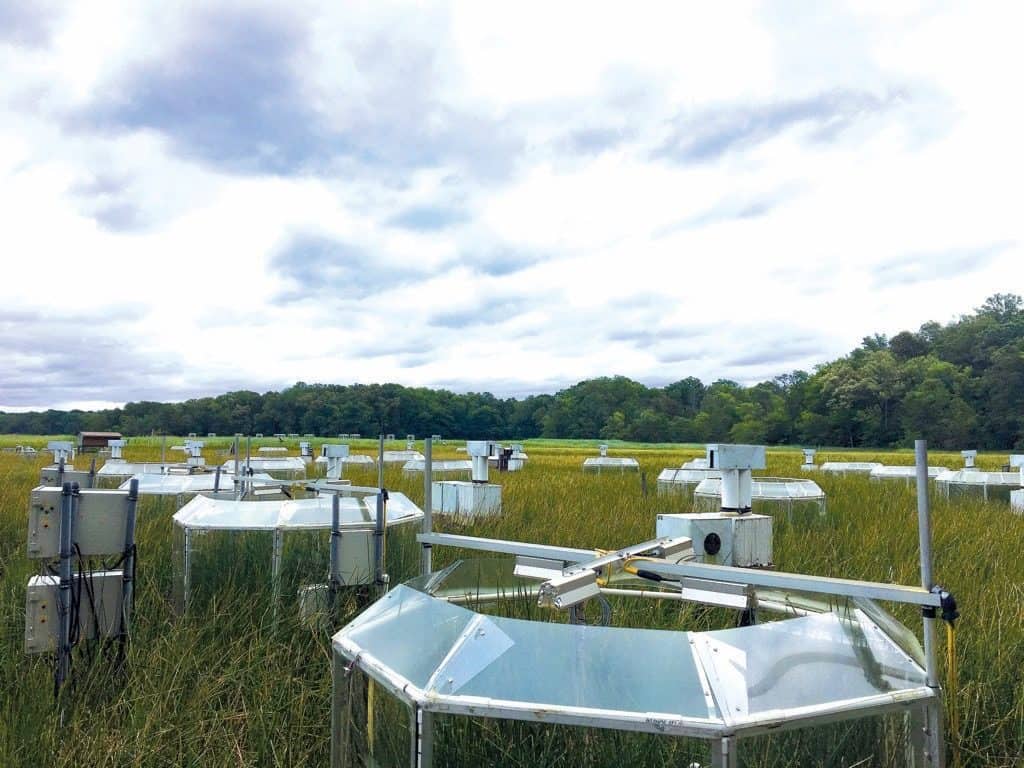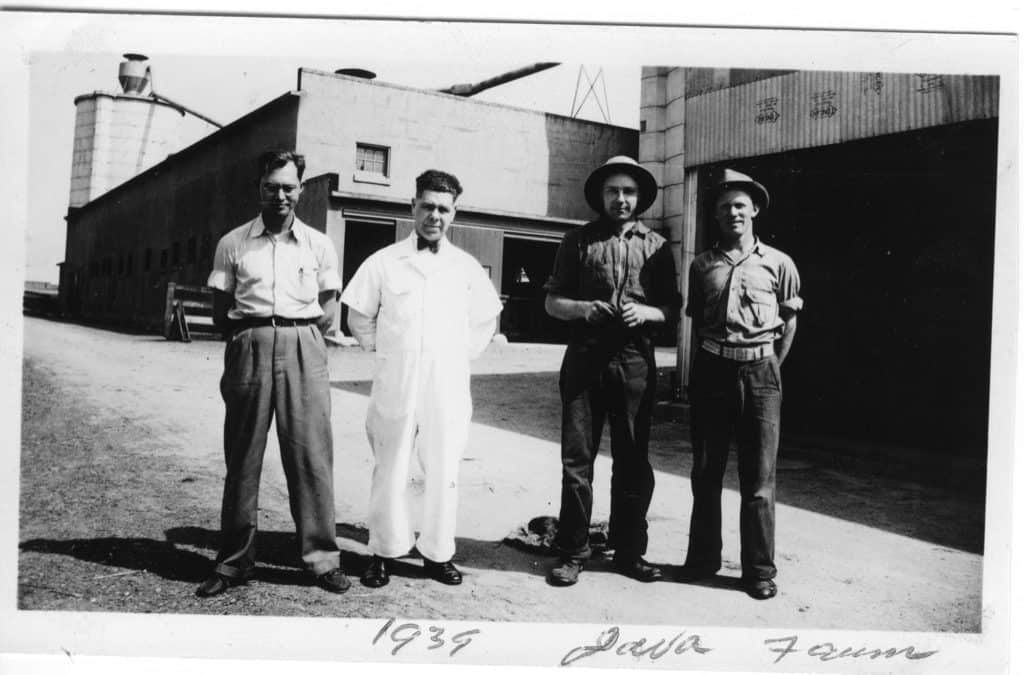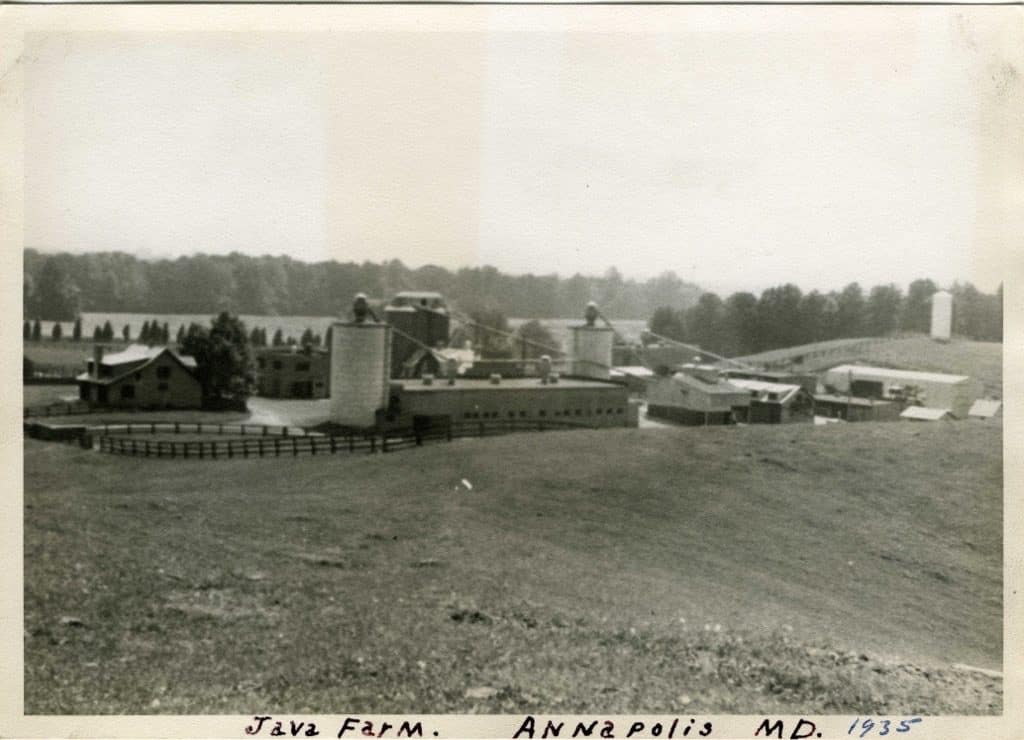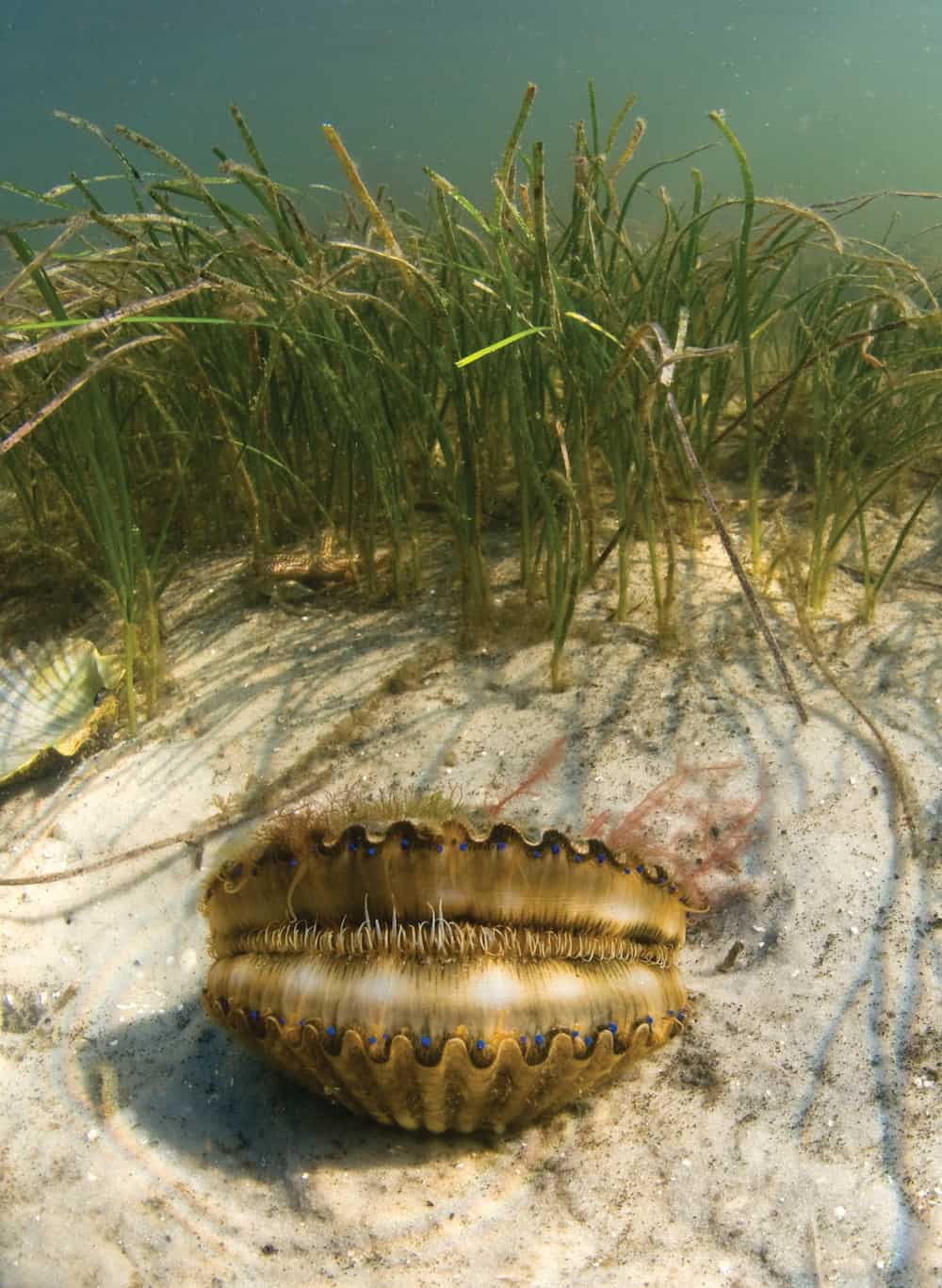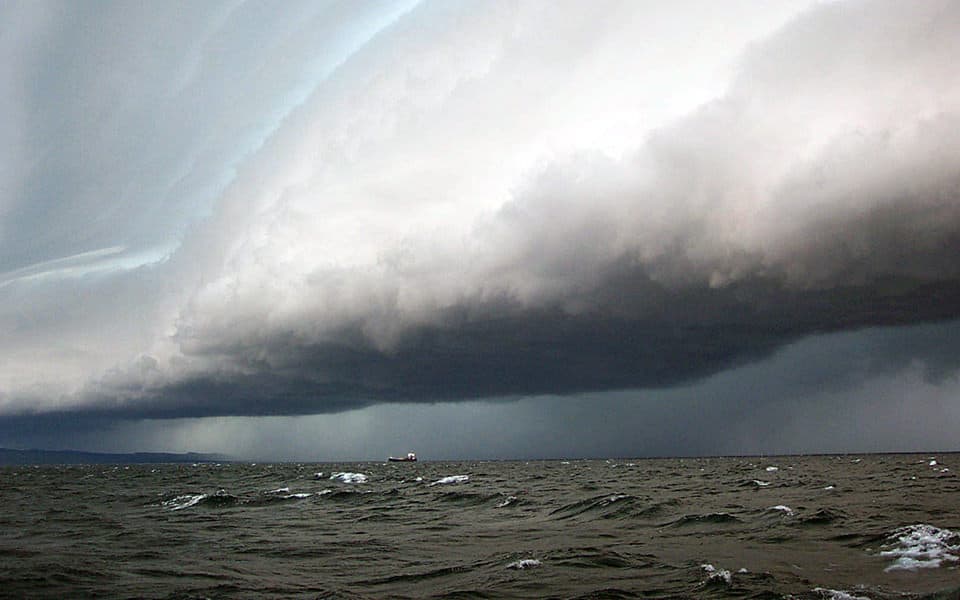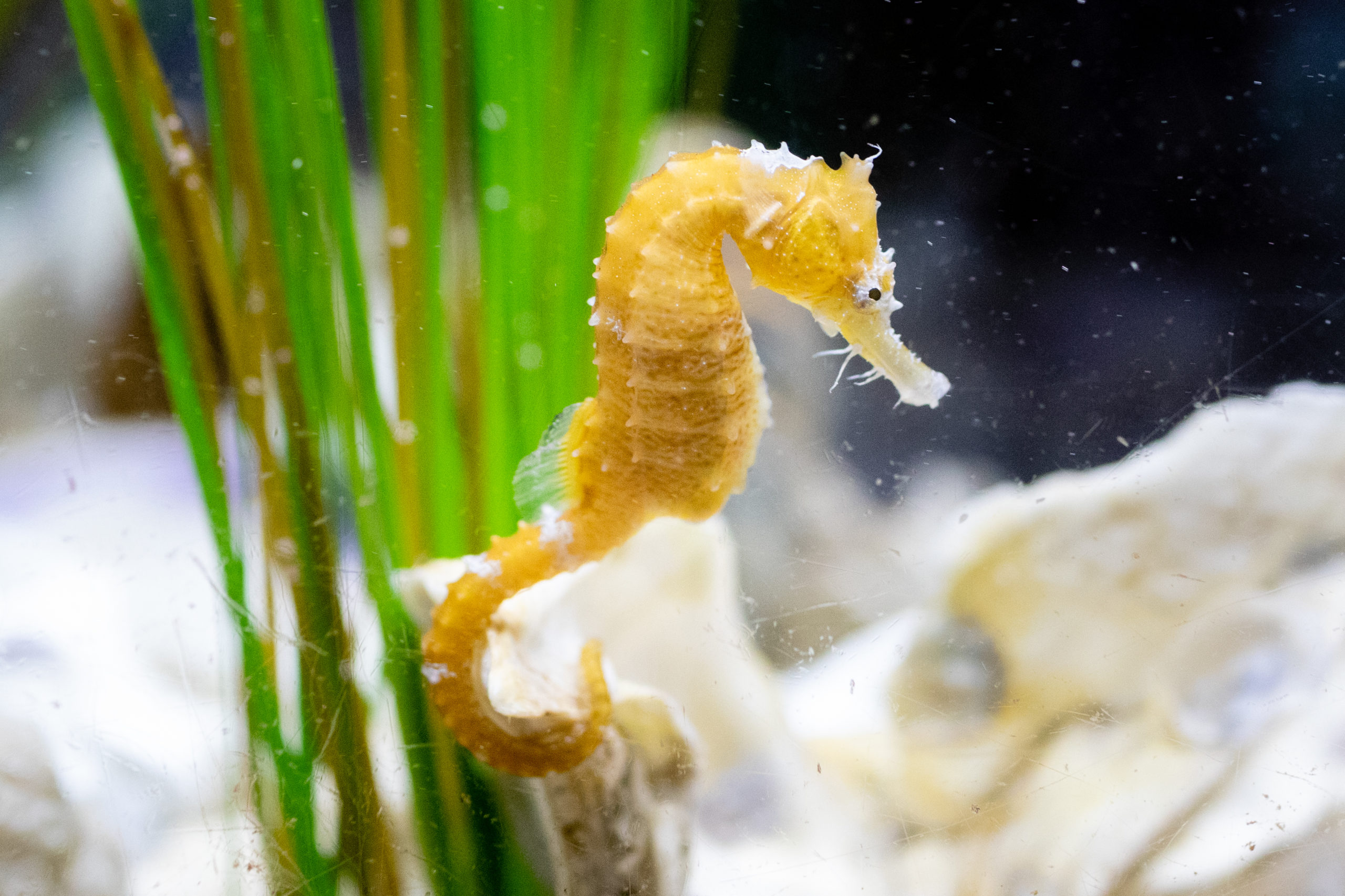Citizen science, education, and crucial research come together along the Rhode River at the Smithsonian Environmental Research Center.
The band on Sally Lechner’s floppy, broad-brimmed hat has sweated through. Her twin neckerchiefs barely absorb the effects of an afternoon in the mid-90s. But as she wipes her eyeglasses, the Edgewater resident looks as happy as a clam at high tide. “Look, look at what we’re standing on,” she says of the catwalk where researchers perch as they measure the height and width of the spiky sedge plants that nearly engulf them. “You could walk to Timbuktu on these!”
She’s here with a handful of other volunteer citizen-scientists to help researchers conduct the Smithsonian Environmental Research Center’s annual marsh grass survey. When Lechner’s scientist-supervisor told the first-time census taker what she’d be doing and why, she says, “I was so excited I asked if I could give her a hug.”
Not every volunteer is as gung-ho as Lechner, but they’re all invaluable additions to SERC’s 115-member scientific staff, which simply has so much work (40 to 50 grant-funded research projects on average) under the purview of 19 different laboratories, that there aren’t enough hands for the tasks. Add to that SERC’s participation in environmental data-sharing and you’ve got ample opportunities for the public to measure marsh grass, monitor tree growth, dig for archaeological artifacts, tag fish, look for invasive species, or examine soil samples in the lab.
It’s late July, and the grasses are at their tallest and greenest. Spring was rainy. Summer brought abundant heat and sunshine. The plants rise to near shoulder height on either side of the narrow, zigzagging boardwalk at the Global Change Research Wetland (known as “GCREW”), an 86-acre experiment where scientists study the effects of global climate change on tidal wetlands, the planet’s best natural buffer against storm surge due to rising sea levels.
As research here has proven, wetlands trap carbon dioxide, storing it in soils. Some plants thrive on it, growing and gaining soil elevation as fast or faster than the water rising at their roots. Since 1987, GCREW researchers have simulated next-century environmental conditions—first exposing marsh grasses to higher levels of carbon dioxide and then increased nitrogen and, more recently, artificially overheating them to measure species response and forecast the marsh’s overall adaptability. It’s the world’s longest-running field experiment on elevated carbon dioxide. And it couldn’t be done without the 50 or so citizen scientists who volunteer every summer to kneel, squat, measure precisely, and perspire heavily in the service of scientific inquiry.
“We couldn’t begin to do the scope of the work we’re doing without them,” SERC’s director, Anson “Tuck” Hines, says of the facility’s approximately 600 citizen scientists. “It’s tens of thousands of hours of assistance that’s very valuable to us. But it’s also great experience for those people because they’re doing real science research driven by the scientists themselves.”
SERC’s wide-ranging research presents citizens with a buffet of inquiries from which to choose: global change, invasive species, biodiversity, food webs, land use, water and soil pollution. “We’re really focused on understanding connected coastal ecosystems, both on the terrestrial side of things and the marine/estuarine side of things,” says Hines, whose specialty is blue crabs.
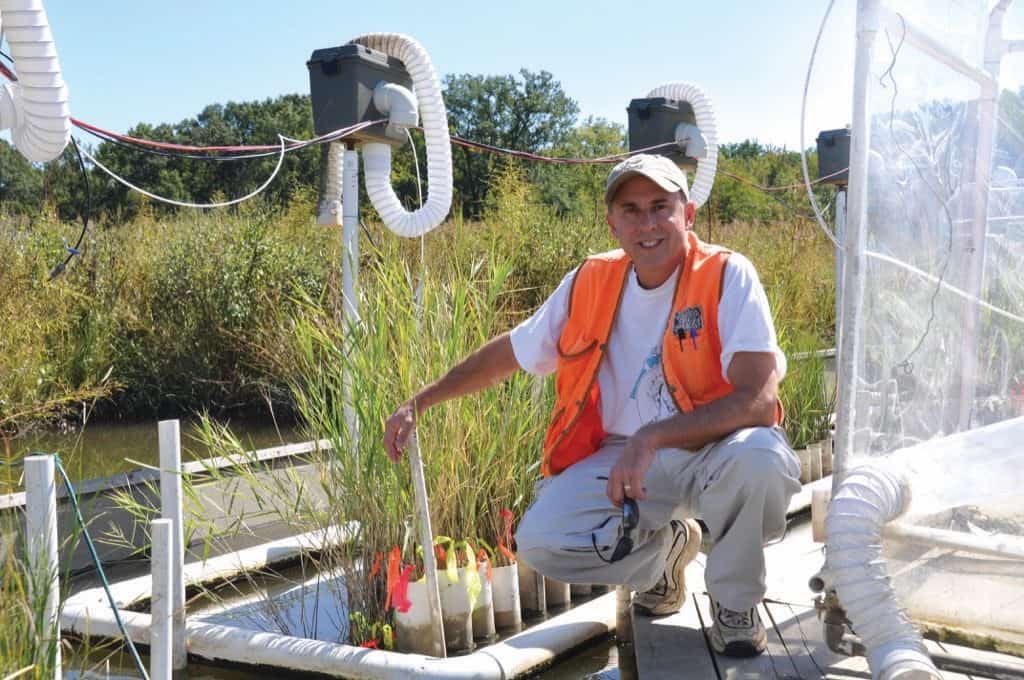
Soil scientist Pat Megonigal sits inside the Global Change Research Wetland, where scientists are running futuristic climate experiments to simulate the world of 2100. Photo: SERC
Pro-am science isn’t a new concept. Alison Cawood, SERC’s coordinator for citizen science for the past five years, says scientists were advertising for volunteer research help as early as the 1840s. Recently, it’s become a recognized discipline. The Citizen Science Association, founded in 2012, devotes itself to advancing research both in the field, through grassroots projects, and virtually, via online data sourcing.
Cawood consolidated SERC’s previously ad hoc program into an institution-wide, quasi Jobs Corps/AmeriCorps for coastal ecosystems. She pairs skill-seeking and community-minded volunteers with archaeologists, biogeochemists, environmental engineers, photobiologists, quantitative ecologists, invertebrate zoologists and other specialists.
“All but one of the labs here actively engage citizen scientists, and that lab still uses citizen science-collected data,” Cawood says. “[Scientists] get help doing things that just aren’t practical to do with your lab staff. They also get the opportunity to talk about their work with people who are really interested in it.”
At first, she says, she doubted whether the more arduous, less glamorous projects would attract any takers. “Seriously, is somebody going to come do that? But they show up and they have fun and they come back and they do it again.”
A global network
No one knows why Robert Lee Forrest bequeathed his nearly 400-acre Anne Arundel County dairy farm and more than $1 million to the Smithsonian Institution. The gift was unexpected, the giver inscrutable.
When Forrest wasn’t speculating in real estate or running his dairy farm, he reportedly dabbled in oceanography. Land made him a millionaire, but oceans evidently captured his imagination. In addition to his generous bequest to the Smithsonian, his will contained another provision: he asked to be buried at sea.
No doubt the real estate investor and layman scientist would like what Java Farm has become a half a century later: a world-renowned environmental research facility where scientists, aided by amateurs much like himself, collaborate to better understand and perhaps save the world’s fragile coastal zones.
Were he still around, Forrest, who died in 1962, might even have been one of the volunteers gathered this day in a large, brackish marsh off the Rhode River near his former farm.
The Rhode River property’s diverse habitat made it a natural for environmental studies, but the man-made features at Java Farm (so named by a 19th-century plantation owner) were less endearing. Amidst 368 acres of overgrown fields and river shoreline, long-abandoned farm buildings had devolved into derelict housing for wild critters.
Some at the Smithsonian wanted to sell Robert Forrest’s surprise bequest, which also included the bachelor’s fortune in real estate holdings, Treasury bills and Borden dairy company stock. But the Smithsonian’s incoming secretary, S. Dillon Ripley, resisted the notion. He thought the property—located roughly 30 miles east of the Smithsonian’s Museum of Natural History—had potential. In 1965, the Smithsonian established the Chesapeake Bay Center for Field Biology (SERC’s original name) as a field collection site. Eventually, biologists moved in, converting the least-dilapidated structures into working spaces and a dormitory.
When Hines came to SERC from California 40 years ago, the staff consisted of “five or six ecologists,” he recalls. His office and lab were in the farm’s old milking barn. Today, modern, energy-efficient buildings house offices, labs, and lodging, and the campus has mushroomed through additional land acquisition to 2,650 contiguous acres where cutting-edge collaborative research is conducted on a global scale, including sites as remote as Belize, the Galapagos Islands, and Panama. SERC’s Forest Ecology Lab, for instance, participates in two international research efforts: the Smithsonian’s Forest Global Earth Observatory network, which monitors forest dynamics in sites worldwide, and the National Science Foundation’s National Ecological Observatory Network (NEON), a standardized platform for gathering long-term environmental data.
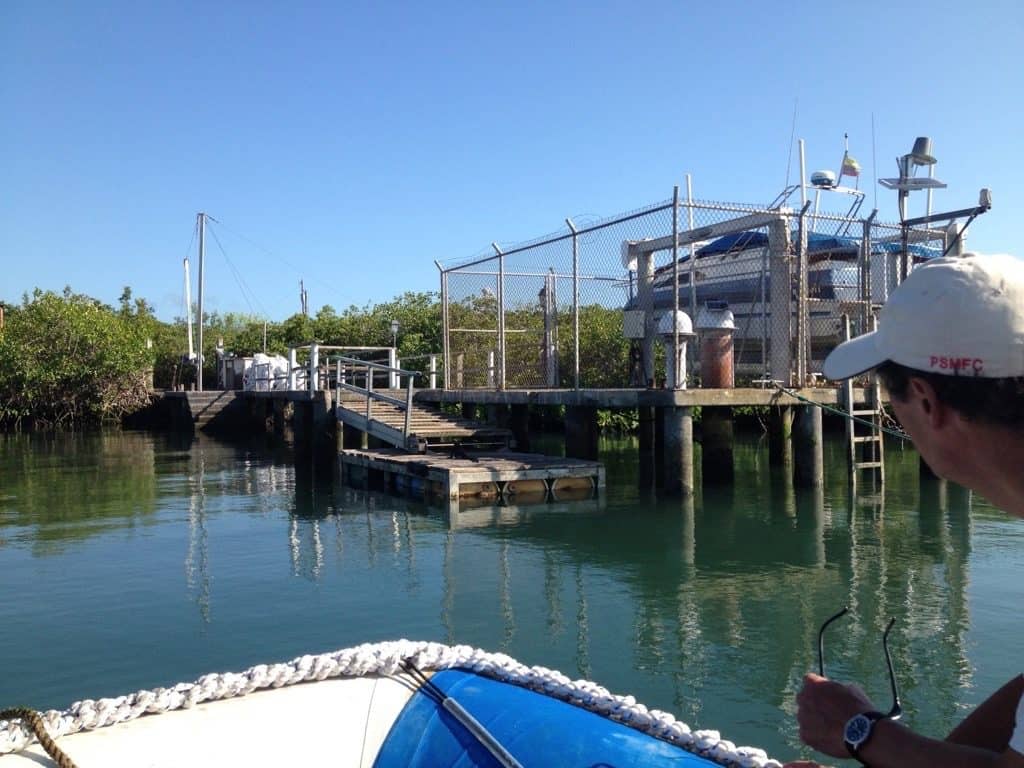
Preparing for Change
“Early on, the notions of climate change—global change—were not prevalent in the scientific community, but there was a lot of interest in trying to understand how we could more wisely manage the environment,” Hines says. “Now our funding is focused on climate change—much of it.”
The research is apolitical, but Cawood says she noticed an increase in volunteerism when partisan tides turned. “After the 2016 election we had a huge pulse of people who really wanted to get involved and get engaged with things,” she says. These days she regularly emails information on volunteer projects to about 1,000 people and relies on 150 or so diehards to tackle almost any task that’s offered. With nearly 20 laboratories involved, it’s quite a mix.
Marine invasive species comprise SERC’s largest research program. Greg Ruiz, who heads the Marine Invasions Lab, began his SERC tenure surveying Chesapeake Bay’s invertebrates, determining which species were native and which weren’t. The lab expanded its surveys to identify invasions on both the East and West Coasts. Researchers had three important questions: Who were these non-natives? Where did they come from? How did they get here?
“We know now, thirty years later, that ships are the major driver for invasions in North America,” Ruiz says. Commercial vessels—and to a lesser extent recreational boats—unknowingly transport invasive species like zebra mussels and Chinese mitten crabs on their hulls, in ballast water, and in cargo. The organisms—nearly 500 different species in the coastal United States—can wreak havoc on local ecosystems.
SERC partners with the U.S. Coast Guard to maintain the National Ballast Information Clearinghouse. Ships arriving at every major U.S. port must report their movements, ballast water management plans, and tank discharges to the database, enabling scientists to study long-term invasion patterns and advise policymakers.
“More and more ships are treating their ballast, but it also shows us that more and more water is coming in because the trade dynamics have changed,” Ruiz says. In Chesapeake Bay, for example, container ships are exporting more oil and liquefied natural gas than previously. When the vessels have delivered their cargo and return, they can import foreign organisms in ballast water, including species previously unknown to scientists.
One especially pernicious Chesapeake invader, a parasitic barnacle nicknamed Loxo, commandeers the reproductive system of native white-fingered mud crabs, sterilizing the host crabs in order to spread its own spawn. (Loxo is thought to have hitchhiked on oysters shipped here from the Gulf of Mexico.) Volunteers assist SERC researchers by collecting tiny mud crabs in the field or examining them microscopically in the lab to detect Loxo’s presence.
Humans have fished in Chesapeake Bay since Native Americans built weirs in the tributaries and Captain John Smith’s men, lacking nets, wielded frying pans to corral “fish, lying so thicke with their heads above the water.” (The natives’ method proved infinitely more effective than the colonists’.) SERC’s Fish and Invertebrate Ecology Lab studies the life cycles of fish, shellfish, crustaceans and smaller creatures and how they’re impacted by fishing and other human activities.
“One problem with coastal ecosystems is changing biodiversity, both the loss of or a greatly reduced abundance of species,” Hines says—oysters being the prime example of a depleted natural resource in the Chesapeake. “Some we’ve managed to recover: blue crabs are sort of holding their own for now; striped bass are sort of holding their own for now. Some are [in the process of] recovering, like river herring and shad.”
Matt Ogburn, one of the lab’s senior scientists, is monitoring oyster reef habitat and river herring recovery in the watershed. Using an advanced form of sonar, scientists are now able to obtain more detailed underwater video imagery than previously possible in the Bay’s murky waters. They’ve used the technology to estimate the population of river herring (alewife and blueback herring) during the fishes’ Bay tributary spawning runs, and to compare the habitat value of restored and unrestored oyster reefs in the Choptank River.
Ogburn likens the sonar device to a high-tech fishfinder. “It allows you to record in both clear and turbid water, day and night,” he says. The footage is then analyzed in the lab—work often performed by citizen scientists—to obtain abundance and size distribution.
By comparing the number of fish and crabs found on restored and natural reefs—along with sanctuary reefs and reefs where oystering is permitted—researchers can evaluate the effectiveness of restoration strategies and harvest regulations on the reefs’ habitat quality. “We think it can be an efficient way to monitor either the large-scale [restoration] sites like the ones NOAA has done, or harvest areas, or small-scale restorations that often don’t get much monitoring,” Ogburn says.

One Big Sandbox
At the riverside Reed Education Center, program coordinator Karen McDonald supervises a sort of SERC in miniature. Schoolchildren visit on field trips to learn about shorelines, the Chesapeake Bay, and the creatures that inhabit them. Adult groups are welcomed, too—McDonald likes to say the center serves “K to gray”—but kids are the primary guests. Nearly 6,000 visited last year, getting hands-on immersion in Bay-based science.
“Everything is geared to mirror what our scientists do,” McDonald says. Where the Fish Ecology Lab performs DNA sequencing to identify the contents of piscine digestive tracts, the kids get to “necropsy” stuffed toy sharks, unfastening their bellies to see what’s inside. (McDonald’s mom sews stomach pouches into toy sharks and rays.) Like SERC’s marine biologists, junior scientists don waders to seine the Rhode’s shallow shoreline, separating their catch into basic critter groups: swimmers, hoppers, crawlers, and floaters.
McDonald brainstorms a changing array of imaginative activities—“my super power,” she says—that mimic research techniques, like having kids suture bananas to understand how scientists tag sharks. The education programs are so popular they’re booked almost a year in advance and McDonald calls on about 50 volunteers to help with instructional and behind-the-scenes work.
Forecasting the impacts of sea level rise. Anticipating invasive species patterns. Teaching the next generation of marine biologists. SERC science tends to be forward-looking.
Jim Gibb’s Environmental Archaeology Lab focuses in the opposite direction. The lab, which has no budget, relies on professionals who donate their time and a coterie of citizen archaeologists to sift through centuries of history at two former tobacco plantations on SERC’s Edgewater campus. “For us it’s like one big sandbox,” Gibb says. “We’re looking at how human interaction changed the environment.”

The SERC campus is located at 647 Contees Wharf Road in Edgewater. For information on citizen science projects, visit serc.si.edu/citizen-science/projects.
“Dig days” are traditionally held every Wednesday and one Saturday a month from April through October. No experience is necessary. At a recent summer dig, 14 amateur archaeologists showed up to excavate a domestic trash pit (called a midden) near the Sellman House whose origins date to 1735. The midden was likely begun in the 19th century, Gibb says.
This day, Under the direction of Gibb and George F. Riseling Jr. (like Gibb, a private archaeology consultant), a few volunteers carefully remove layers from the excavation site. Stationed at large, elevated sieves, other volunteers sort through bucket loads of exhumed soil, picking out animal bones, bits of porcelain, oyster shells, coal fragments and other clues to what past residents ate and how they lived. One of the “sifters” is Sally Lechner, the uber-enthusiastic volunteer from the marsh grass survey. She’s no less excited about amateur archaeology. Lechner says she attended a SERC lecture and was so smitten with the campus’s natural setting that she returns again and again for citizen science projects.
Cawood says one dig-day participant, a young woman, so enjoyed herself that she went on to earn her masters in archaeology and now makes it her profession. “She just showed up because she wanted to do something … and her mom wanted her out of the house.”

